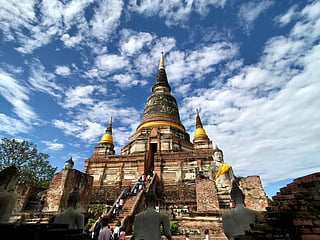- Destinations
- Experiences
- Stay
- What's new
- Celebrating People
- Responsible Tourism
- CampaignsCampaigns
- Subscribe
- Buy Now

With its rich and complex history, Vietnam offers a treasure trove of historical sites that provide a fascinating glimpse into its past. From ancient temples and imperial citadels to war museums and colonial-era remnants, this Southeast Asian country boasts a diverse range of historical attractions. If you're a history enthusiast or simply a traveller interested in culture and heritage, exploring Vietnam's historical sites is a must. Here are some of the best historical sites in Vietnam.
For history-loving travellers, the Imperial Citadel of Thăng Long in Hanoi, Vietnam, is a mesmerising destination that offers a journey back in time. This UNESCO World Heritage Site is a treasure trove of historical significance, dating back over a thousand years.
The Citadel served as the political and cultural heart of Vietnam for many dynasties, making it a living testament to the country's rich heritage. Wander through the ancient gates, stone walls, and ornate structures, and you'll be transported to the days of emperors and dynastic rule. The site showcases the unique blend of architectural styles influenced by Chinese and Southeast Asian cultures.
Visitors can explore the archaeological digs that have unearthed valuable artefacts, shedding light on Vietnam's past. The Citadel's numerous pavilions, palaces, and temples offer an immersive experience of the traditions, rituals, and power dynamics of bygone eras.
For history enthusiasts, the Imperial City of Huế, located in central Vietnam, is a captivating historical gem that whispers tales of Vietnam's imperial past. This UNESCO World Heritage Site boasts a rich and complex history dating back to the Nguyen Dynasty.
Once the imperial capital of Vietnam, the city's remarkable architecture and layout reflect the opulence and grandeur of bygone eras. Enclosed within massive stone walls and a protective moat, the Imperial City showcases a harmonious blend of traditional Vietnamese and Chinese architectural styles. Its sprawling complex includes the Forbidden Purple City, the emperor's private residence.
Exploring the Imperial City is like stepping into a time machine. The meticulously preserved buildings, courtyards, and gardens transport you to a period of emperors, courtly traditions, and elaborate ceremonies. The city's museums and exhibits provide deep insights into Vietnamese history and culture.
Hội An, a charming town on the central coast of Vietnam, is an enchanting destination for history-loving travellers. With its well-preserved ancient architecture, Hội An offers a glimpse into the region's rich history and cultural heritage.
This UNESCO World Heritage Site was once a bustling international trading port and retains a unique fusion of Vietnamese, Chinese, Japanese, and European architectural influences. The old town is a labyrinth of narrow streets lined with well-preserved historic buildings, ancient temples, and ornate merchant houses. The iconic Japanese Covered Bridge, dating back to the 18th century, is a symbol of Hội An's historical significance.
Visitors can explore traditional tea houses, art galleries, and handicraft shops that continue centuries-old traditions. The town's vibrant lantern-lit streets create a romantic and nostalgic ambience, evoking a sense of timelessness.
My Son, a UNESCO World Heritage Site in central Vietnam, is a must-visit destination for history-loving travellers. This ancient sanctuary holds the keys to a rich and mystical past, making it a fascinating historical treasure.
My Son was the spiritual heart of the Champa Kingdom, an ancient civilization that thrived between the 4th and 13th centuries. The site is home to a complex of Hindu temples and religious structures dedicated to the god Shiva. These temples' exquisite architecture and intricate carvings stand as a testament to the Cham people's craftsmanship and devotion.
Visitors can explore the various temple groups, admiring the red-brick towers set against a lush, forested backdrop. Despite the ravages of time and conflict, the site still exudes an aura of spiritual significance and historical grandeur.
The Tomb of Khải Định in Huế, Vietnam, is a historical marvel that will captivate history enthusiasts and architecture aficionados alike. This opulent tomb, designated as a UNESCO World Heritage Site, is a testament to the fusion of traditional Vietnamese design and French colonial influences.
Emperor Khải Định's final resting place is an exquisite blend of European and Asian architectural styles, making it a unique and visually stunning monument. The tomb's interior is adorned with intricate mosaics, glass, and porcelain, reflecting an awe-inspiring commitment to detail and craftsmanship.
As visitors explore the tomb's various chambers, courtyards, and staircases, they gain insight into the life and reign of Emperor Khải Định. The intricate artwork and the view from the hilltop location offer a sense of grandeur and historical significance.
